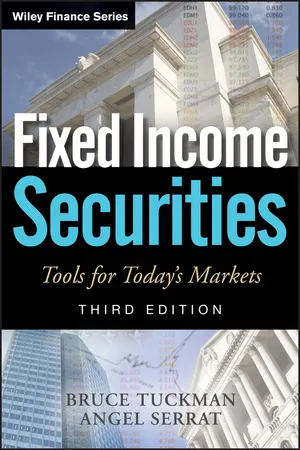
- English
- ePUB (mobile friendly)
- Available on iOS & Android
About this book
Fixed income practitioners need to understand the conceptual frameworks of their field; to master its quantitative tool-kit; and to be well-versed in its cash-flow and pricing conventions. Fixed Income Securities, Third Edition by Bruce Tuckman and Angel Serrat is designed to balance these three objectives. The book presents theory without unnecessary abstraction; quantitative techniques with a minimum of mathematics; and conventions at a useful level of detail.
The book begins with an overview of global fixed income markets and continues with the fundamentals, namely, arbitrage pricing, interest rates, risk metrics, and term structure models to price contingent claims. Subsequent chapters cover individual markets and securities: repo, rate and bond forwards and futures, interest rate and basis swaps, credit markets, fixed income options, and mortgage-backed-securities.
Fixed Income Securities, Third Edition is full of examples, applications, and case studies. Practically every quantitative concept is illustrated through real market data. This practice-oriented approach makes the book particularly useful for the working professional.
This third edition is a considerable revision and expansion of the second. Most examples have been updated. The chapters on fixed income options and mortgage-backed securities have been considerably expanded to include a broader range of securities and valuation methodologies. Also, three new chapters have been added: the global overview of fixed income markets; a chapter on corporate bonds and credit default swaps; and a chapter on discounting with bases, which is the foundation for the relatively recent practice of discounting swap cash flows with curves based on money market rates.
Frequently asked questions
- Essential is ideal for learners and professionals who enjoy exploring a wide range of subjects. Access the Essential Library with 800,000+ trusted titles and best-sellers across business, personal growth, and the humanities. Includes unlimited reading time and Standard Read Aloud voice.
- Complete: Perfect for advanced learners and researchers needing full, unrestricted access. Unlock 1.4M+ books across hundreds of subjects, including academic and specialized titles. The Complete Plan also includes advanced features like Premium Read Aloud and Research Assistant.
Please note we cannot support devices running on iOS 13 and Android 7 or earlier. Learn more about using the app.
Information
Table of contents
- Cover
- Endorsement
- Series
- Title Page
- Copyright
- Preface to the Third Edition
- Acknowledgments
- An Overview of Global Fixed Income Markets
- Part One: The Relative Pricing of Securities with Fixed Cash Flows
- Part Two: Measures of Interest Rate Risk and Hedging
- Part Three: Term Structure Models
- Part Four: Selected Securities and Topics
- References
- Index